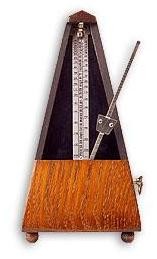
Metronome |

from the Greek métron – measure and nomos – law
A device for determining the tempo of the music being played. prod. by accurate counting of the duration of the meter. M. consists of a spring clock mechanism built into a pyramid-shaped case, a pendulum with a movable sinker, and a scale with divisions indicating the number of oscillations made by the pendulum per minute. The swinging pendulum produces clear, jerky sounds. The fastest swing occurs when the weight is at the bottom, near the axis of the pendulum; as the weight moves towards the free end, the movement slows down. Metronomic the designation of the tempo consists of the note duration, taken as the main. metric share, an equal sign and a number indicating the required number of metric. share per minute. For example,  = 60 or
= 60 or  = 80. In the first case, the weight is set approx. divisions with the number 60 and the sounds of the metronome correspond to half notes, in the second – about division 80, quarter notes correspond to the sounds of the metronome. M.’s signals have predominance. educational and training value; musicians-performers M. is used only at an early stage of work on a work.
= 80. In the first case, the weight is set approx. divisions with the number 60 and the sounds of the metronome correspond to half notes, in the second – about division 80, quarter notes correspond to the sounds of the metronome. M.’s signals have predominance. educational and training value; musicians-performers M. is used only at an early stage of work on a work.
Apparatuses of the M type appeared at the end of the 17th century. The most successful of these turned out to be the M. of the system of I. N. Meltsel (patented in 1816), which is still used today (in the past, when designating M., the letters M. M. – Melzel’s metronome) were put in front of the notes.
K. A. Vertkov



